
* Although the Corsair's development was more or less untroubled, by prewar standards it was a powerful and unruly beast, and it took time, determination, and blood to bring it up to fighting standard. Once it got flying right, however, the Corsair proved everything hoped for it, serving ably in both air combat and close air support attacks, to become a significant contribution to Allied victory.
* On 1 February 1938, the US Navy issued a request for proposals for a new high-performance single-seat carrier-based fighter that would use the most powerful engine available at the time. At the Vought-Sikorsky (later Chance Vought) Division of the United Aircraft Corporation (UAC) group in Connecticut, a design team under Rex B. Beisel decided to build the aircraft, which they referred to as the "Model V-166B", around the new XR2800 Double Wasp 18-cylinder two-row air-cooled radial engine, with 1,500 kW (2,000 HP), built by Pratt & Whitney (P&W), another UAC division.
Such a large engine needed a big propeller to soak up the power, and so the design featured a 4.06 meter (13 foot 4 inch) three-blade variable-pitch constant-speed propeller designed by Hamilton Standard, yet another UAC division. The big propeller posed a problem for the design team. It dictated long landing gear so that the prop arc would clear the ground on take-offs and landings, but long landing gear tended to be too weak to tolerate hard carrier landings. The designers came up with the notion of a low-mounted "inverted gull wing" or "cranked wing", in which the wings bent down from the root and then back up to the tip, with the main landing gear at the lowest point of the wing. The right-angle connection between the wing and the fuselage cleaned-up aerodynamics, reducing drag. There were prominent intakes in the front of the inboard stub wings, for the oil coolers and the supercharger intercooler.
The US Navy ordered a prototype of the Vought design as the "XF4U-1" in June 1938. Armament was planned as two 7.62-millimeter (0.30-caliber) Browning machine guns in the top of the nose and a single 12.7-millimeter (0.50-caliber) Browning machine gun in each wing, for a total of four guns. The prototype also had little bomb bays in the outer wings for fragmentation bombs that would be dumped on enemy bomber formations, with a window in the cockpit floor for sighting. The bomb bays were a screwball idea that would be quickly abandoned.
Vought engineers completed a full-scale mockup of the XF4U-1 in early 1939 for wind tunnel tests and Navy inspection. The initial flight of the prototype XF4U-1 was on 29 May 1940, with Vought chief test pilot Lyman A. Bullard JR at the controls. The aircraft suffered from excessive vibration, leaving Bullard in an agitated mood when he got back to the ground. The prototype was badly damaged in July, when storms prevented test pilot Boone T. Guyton from reaching the Vought airfield at Stratford, Connecticut. He was running low on fuel and couldn't raise any other airfield on his radio, so he tried to put the machine down on a golf course at Norwich, Connecticut. He touched down properly, but the grass was slick with rain, and he plowed into trees, flipping the aircraft over and around. One wing was torn off, the fuselage was bashed up -- but Guyton was little more than shaken and bruised, thanks to the toughness of the design.
The prototype was rebuilt in a few months, demonstrating the design's performance on 1 October 1940, clocking 650 KPH (404 MPH). However, the promise of the type was balanced by continuing difficulties, including a nasty inclination of the Double Wasp engine to catch on fire; a tendency of the engine to conk out at high altitude; and some unpleasant handling problems, such as bad spin recovery. Some things were fixed, others were inherent in the design -- when Boone Guyton was later asked by Navy pilots about spinning the F4U, his answer was minimal: "Don't."

The problems clearly meant delays in getting the type into production. To compound the delays, reports coming back from the war in Europe indicated that an armament of two 7.62-millimeter and two 12.7-millimeter machine guns was too light, and so when the US Navy asked for production proposals in November 1940, heavier armament was specified. The twin 7.62-millimeter Brownings in the nose were eliminated and two 12.7-millimeter Brownings were fitted in each wing. The wing guns were staggered to avoid mechanical interference between their ammunition feeds. The armament change required considerable design adjustments, piling up more delays.
There was another troublesome consequence: putting all the guns in the wings meant eliminating wing fuel tankage, and so the forward fuselage was stretched by 45 centimeters (18 inches) to include a new self-sealing tank in the center of the fuselage. The fuel tank also meant moving the cockpit back by about 91 centimeters (3 feet), which made it hard for a pilot to see over the nose when taxiing, taking off, or landing. There would never be any way around the long nose, one pilot later recollecting that he used to tell himself after he lined up for the approach: "God, I hope there's nobody on that runway!"
* Formal naval acceptance trials for the XF4U-1 began in February 1941, and the initial Navy production order for 584 "F4U-1s" was placed on 30 June 1941. The type was given the name "Corsair", which had been the name of several prewar Vought aircraft. The first production F4U-1 performed its initial flight on 24 June 1942, once again with Boone Guyton at the controls.
The type quickly underwent a few more improvements, with the number of 12.7-millimeter Brownings in each wing increased to three, for a total of six; the addition of 70 kilograms (155 pounds) of armor around the cockpit and the oil tank, plus an armor glass windscreen and self-sealing fuel tanks; fit of shorter flaps and wider ailerons; and installation of an uprated R-2800-8 Double Wasp engine with a two-stage supercharger and 1,490 kW (2,000 HP) take-off power to handle the aircraft's increased weight.
The US Navy received its first production F4U-1 on 31 July 1942, with carrier trials beginning on the USS SANGAMON on 25 September 1942. Getting the machine into service proved difficult. The framed "birdcage" style canopy gave a poor field of view for deck taxiing, a serious concern given the kind of damage the oversize prop could do to anybody or anything that got in its way. Even more seriously, the machine had a nasty tendency to "bounce" on touchdown, which could cause it to miss the arresting hook and slam into the crash barrier, or even go out of control. The long "hose nose" visibility problem has already been mentioned, and there was the inevitable issue of the enormous torque of the Double Wasp: if a pilot was waved off a carrier landing, he would throttle up and bank off to the left for another pass, and the Corsair had an evil tendency to flip over on its back if revved up incautiously. Yet another peculiarity was that, due to propwash effects, the left wing would stall before the right on the landing approach, which tended to make the aircraft roll to the left as well.
Production was going ahead anyway, with Vought building 178 Corsairs by the end of 1942. The company was working with the US Marine Corps -- which saw the potential of the type and by nature was less intimidated than the Navy by the aircraft's unpleasant features, seeing them more as a challenge -- to work out the bugs in parallel with production. Although the Navy would come to accept the F4U, the Corsair would always be more of a Marine than a Navy fighter. The type was declared "ready for combat" at the end of 1942, though it was originally only qualified to operate from land bases until carrier qualification issues were worked out.
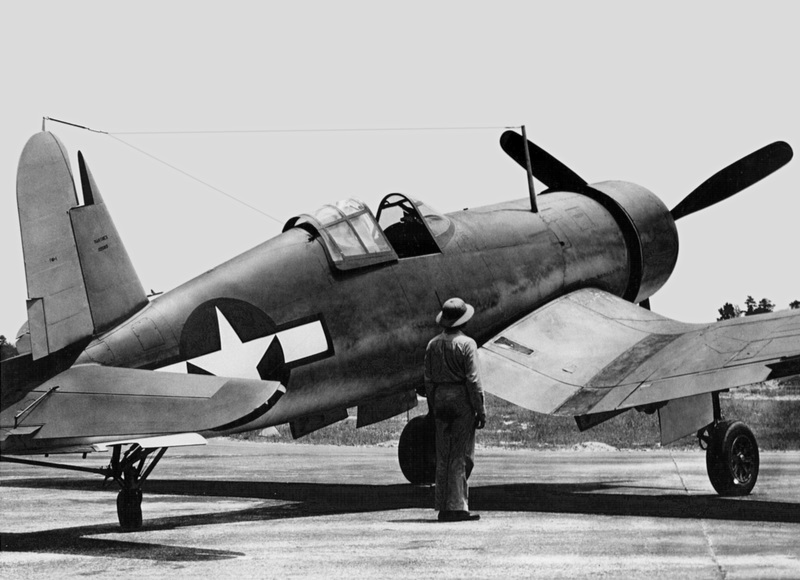
A dozen F4U-1s arrived at Henderson Field on Guadalcanal in the Solomon Islands on 12 February 1943. The US Navy didn't get into combat with the type until September 1943, and in fact the British Royal Navy's Fleet Air Arm (FAA) would qualify the type for carrier operations first.
* It was an indication of the haste in which the US was putting new combat aircraft into production at the time that well before Vought began production of the F4U, other manufacturers were being enlisted to build the Corsair, with Goodyear signed up in November 1941 and Brewster following in December. The Goodyear variant of the F4U-1 was designated the "FG-1" and featured fixed instead of than folding wings; it was intended to fly off land bases, not carriers. Initial flight of the first Goodyear FG-1 was on 25 February 1943, with deliveries beginning in April. The Brewster version was the "F3A-1", and was essentially identical to the F4U-1. Initial flight of the first Brewster F3A-1 was on 26 April 1943, with deliveries beginning in July.
BACK_TO_TOP* The F4U-1, as it emerged, was an aircraft that would be difficult to confuse with any other in widespread service at the time, or for that matter later. It was easily recognized by its gull wing and the big three-bladed Hamilton Standard propeller, powered by an R-2800-8 engine. It was also a big machine by the standards of the time; a set of handholds / footsteps was embedded in the right side of the fuselage beneath the cockpit to allow the pilot to get in and out without a ladder.
The F4U-1 was of basically conventional monocoque construction, made mostly of metal, although the ailerons had wood frames and plywood skinning, while the rudder, elevators, and outer wings had metal frames and fabric skinning. The flaps were all metal. The tailfin was slightly offset from the centerline to help compensate for engine torque. There were trim tabs on the ailerons and the rudder.
The Corsair was exceptionally strong and featured substantial armor protection. The main landing gear was fitted into the inner wing section, just inside the "bend" where the wing fold was, and rotated 90 degrees to lie flat inside the wing. The tailwheel was semi-retractable. There was a stinger-type arresting hook just behind the tailwheel.

There were inlets in the leading edge of the wings near the wingroot for the supercharger and oil cooler system. Although the original internal wing fuel tanks had been removed, the design team figured out how to cram a small tank into each outer wing. The wings hydraulically folded straight up toward the aircraft centerline. The three Browning machine guns in each wing were just outboard of the wing fold. The two inner guns had an ammunition capacity of 400 rounds per gun each, while the outer gun had 375 rounds per gun, with the pilot aiming the guns with a reflector-type gunsight. The F4U-1 could carry a centerline external fuel tank with a capacity of 662 liters (175 US gallons).
The F4U-1, as mentioned, originally had a framed, backwards sliding canopy, with "cutouts" behind it, like those used on the Curtiss P-40 Warhawk, to improve rearward visibility. Electronics included a multichannel radio and the new "identification friend or foe (IFF)" set, developed by the British. The cockpit was roomy by the standards of the time. A typical early color scheme was two-tone light and medium blue on top, with light gray on the bottom.
Some F4U-1s were modified in the field for the photo-reconnaissance role and designated "F4U-1P". They were fitted with a vertically mounted K-21 camera in the belly, between the trailing edge of the wing and the tailwheel. The number of conversions is unclear.
* As mentioned, the Corsair's initial deficiencies were being worked out on a concurrent basis. The tendency to "bounce" on landings, due to the excessive stiffness of the shock absorber elements in the main landing gear struts, was greatly reduced after Vought engineers tweaked the stiffness to get the right value. The 689th production F4U-1 featured a number of significant changes. The most noticeable was that the cockpit was raised 18 centimeters (7 inches) to improve the pilot's forward view, and a clear-view bulged canopy, along the lines of the "Malcolm Hood" used on later model Spitfires, replaced the original "birdcage" framed canopy to provide better all-round field of view.
Other changes included a raised tailwheel leg -- with a pneumatic instead of solid tire -- to improve the pilot's forward view on the ground; and an almost unnoticeable 15-centimeter (6-inch) fixed "stall strip" that was fitted to the leading edge of the right wing outboard of the guns to ensure that both wings stalled at the same time on landing approach. The 1,550th production F4U-1 introduced the R-2800-8W engine, with water-methanol injection for boost power of 1,664 kW (2,230 HP).
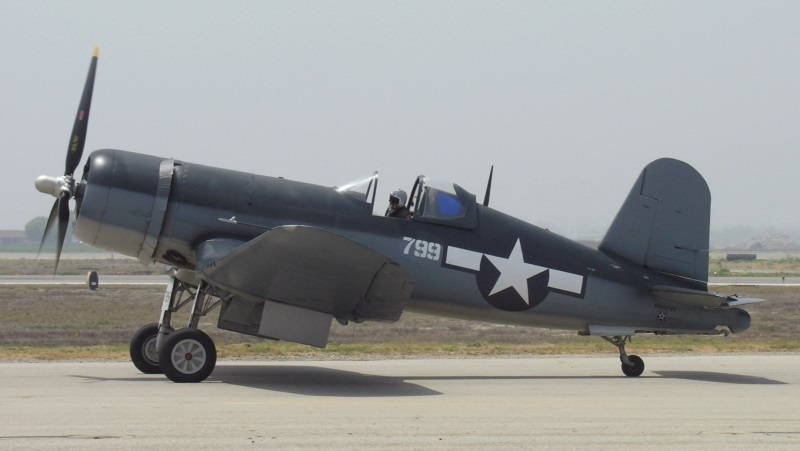
F4U-1s with the new canopy were later retroactively designated "F4U-1A". Although sources vary widely on the number of F4U-1As built, 2,126 seems a reasonable value. The Goodyear equivalent was the "FG-1A", which like the FG-1 lacked wing fold.
___________________________________________________________________
VOUGHT F4U-1A CORSAIR:
___________________________________________________________________
wingspan:
12.49 meters (41 feet)
wing area:
29.17 sq_meters (314 sq_feet)
length:
10.16 meters (33 feet 4 inches)
height:
4.9 meters (16 feet 1 inch)
empty weight:
4,074 kilograms (8,892 pounds)
MTO weight:
6,350 kilograms (14,000 pounds)
max speed at altitude:
671 KPH (417 MPH / 363 KT)
service ceiling:
11,250 meters (36,900 feet)
range:
1,633 kilometers (1,015 MI / 883 NMI)
___________________________________________________________________
* The "F4U-1C" was introduced in August 1943, and featured four M2 20-millimeter cannon in place of the six 12.7-millimeter Brownings; the cannons had 120 rounds each. The F4U-1C was otherwise much like the F4U-1A. The F4U-1C's four cannon proved particularly useful in the ground-attack role. The F4U-1C went into service in the spring of 1945, and 200 were built by Vought.
* The "F4U-1D" was introduced in April 1944, though the F4U-1C remained in production in parallel. The F4U-1D was much the same as the F4U-1A, retaining the six Browning machine guns, and differed mainly in that the internal wing fuel tanks were deleted, the variant instead being fitted for carriage of a 605-liter (160 US gallon) centerline drop tank. It could also carry two 450-kilogram (1,000-pound) bombs, one on each inner wing near the wingroot; these stores racks were also "wet" and could carry fuel drop tanks. The idea of using the Corsair to carry heavy munitions had been developed in the field, with operational squadrons improvising bomb racks for the purpose. The F4U-1D made it "official". F4U-1Ds were all painted in the standard color scheme for Corsairs at the time, a dark overall sea blue.

Vought built a total of 1,685 F4U-1Ds. Goodyear built the F4U-1D as the "FG-1D", delivering a total of 1,997 (some sources claim 2,303) aircraft. Brewster also built it as the "F3A-1D", though Brewster was out of the Corsair business by July 1944. The company had only delivered a total of 735 Corsairs by that time, and the Navy terminated the contract with the company, citing unsatisfactory management. Brewster's efforts during the war proved so troublesome that there were rumors that Nazi agents had infiltrated the organization and were causing all the trouble -- but that sounds like a gag.
Late production F4U-1Ds and FG-1Ds featured four launch rails on each outer wing for 12.7 centimeter (5 inch) "High Velocity Aircraft Rocket (HVAR)" projectiles. The rockets were sighted through the gunsight and proved accurate. Apparently some earlier-production Corsairs were also kitted up to fire the rockets. Late in the war, Vought converted an F4U-1D into a tandem-seat trainer, but nobody was interested and it didn't go into production.
BACK_TO_TOP* The Corsair, as mentioned, had begun its first combat deployment, to Guadalcanal, in early 1943. The first recorded combat engagement was on 14 February 1943, when Corsairs of Marine Squadron VMF-124 under Major William E. Gise assisted P-40 Warhawks and P-38 Lightnings in escorting B-24 Liberators on raids against the major Japanese base at Bougainville at the northwest corner of the Solomons. Japanese fighters contested the raid and the Americans got the worst of it, with four P-38s, two P-40s, two Corsairs, and two Liberators lost. No more than four Japanese Zeroes were destroyed. A Corsair was responsible for one of the "kills", but it wasn't anything to boast about, since it was due to a midair collision. The fiasco was referred to as the "Saint Valentine's Day Massacre".
Although the Corsair's combat debut was unimpressive, the Marines quickly learned how to make better use of the machine and demonstrate its superiority over Japanese fighters. By April 1943, the Corsair was getting the upper hand. By May, VMF-124 had produced the first Corsair ace, 2nd Lieutenant Kenneth A. Walsh, who would rack up a total of 21 kills during the war.
According to old stories, the Japanese learned to call the F4U "Whistling Death" because of the high-pitched sound it made, though such a melodramatic name sounds suspiciously like an invention of American publicists. It was also known as the "Bent Wing Bird" -- though this name sounds suspiciously like something out of company press releases. Whatever the enemy or the aircrew actually called the F4U, it was still a machine to be reckoned with, one way or another. Many pilots became aces in the Corsair, but even its most smitten advocates admitted that it was a handful.
The most prominent gang of Marine Corsair pilots was squadron VMF-214, led by Major (later Colonel) Greg "Pappy" Boyington. Boyington was a rowdy, tough, hard-drinking Marine who had flown Curtiss P-40s with Claire Chennault's American Volunteer Group (AVG) or "Flying Tigers" in China, and scored two kills there. Chennault had thrown him out after somebody broke into the liquor locker -- concluding that Boyington was responsible, because nobody else in the Flying Tigers was strong enough to have wrenched open the padlock with his bare hands.
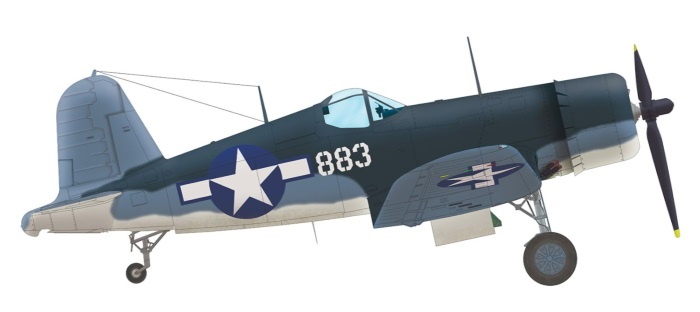
VMF-214 "Boyington's Bastards" or "Black Sheep" racked up large scores against the Japanese in the South Pacific, with Boyington claiming a total of 28 kills during his combat career, 22 of them in the F4U. He was shot down and captured by the Japanese on 3 January 1944, to spend the rest of the war in a prison camp; the Japanese did not announce his capture, and Boyington was presumed killed in action. He would get the Medal of Honor after his release from captivity at the end of the war.
* After finally working out the worst bugs, the Navy finally embraced the Corsair as the most capable fighter and fighter-bomber in its inventory, superior to the Grumman F6F-3 Hellcat. By early 1944, the Navy was making good use of the Corsair. The first Navy F4U squadron, VF-17 "Jolly Rogers" AKA "Skull & Crossbones", produced 12 aces, the most prominent being Lieutenant Ira Kepford, with 19 kills.
By the spring of 1944, Marine pilots were beginning to exploit the type's considerable capabilities in the close air support role, backing up amphibious landings with 450-kilogram (1,000-pound) bombs. The famed pilot Charles Lindbergh flew Corsairs with the Marines as a civilian technical adviser in order to determine how best to increase the Corsair's warload and effectiveness in the attack role. Lindbergh managed to get the F4U into the air with 1,800 kilograms (4,000 pounds) of bombs, including a 900-kilogram (2,000 pound) bomb on the centerline and a 450-kilogram (1,000-pound) bomb under each wing. In the course of such experiments, he performed strikes on Japanese positions during the battle for the Marshall Islands.
By the beginning of 1945, the Corsair was a full-blown "mudfighter", performing strikes with high-explosive bombs, napalm tanks, and HVARs. In dive-bombing attacks, it was almost as accurate as the Douglas SBD "Slow But Deadly" dive-bomber. The F4U was a prominent participant in the fighting for the Palaus, Iwo Jima, and Okinawa, with the ground-pounders calling it the "Sweetheart" for its welcome services when things were getting nasty.

In the last months of the conflict, the F4U also carried the oversized 29.8 centimeter (11.75 inch) "Tiny Tim" unguided rocket on the wingroot pylons for cracking Japanese strongpoints. The Tiny Tim had to be dropped on a trapeze pylon to clear the propeller; qualifying the rocket for carriage proved troublesome, with a number of Corsairs lost in the process. Experiments were performed in 1944 with an old F4U-1 with "jet assisted take-off (JATO)" gear, featuring a small solid-fuel rocket attached to the fuselage just behind each wingroot, to allow the Corsair to get off the ground more easily with heavy loads -- but it appears that JATO was rarely, if ever, used in service with the Corsair.
One unusual store carried by the Corsair was an ice-cream factory. Late in the war, one squadron in the Palaus found the action slow, and to stave off boredom the ground crews rigged 19-liter (5 US gallon) cans with a wind-driven spinner connected to a mixing rotor, and hooked up one under each wing of an F4U. A pilot would take the aircraft up to high altitude for a given period of time, and then come back to base with the ice cream.
Statistics compiled at the end of the war indicate that the F4U flew over 64,000 operational sorties for the US Marines and US Navy through the conflict, with fewer than 10,000 of these sorties from carrier decks. The total number of kills claimed was 2,139, against 189 combat losses of F4Us, for a kill ratio of over 11:1. Even if that was exaggerated by a factor of two, it was still an accomplishment. One particularly interesting kill was scored by a Marine Lieutenant R.R. Klingman over Okinawa. According to the story, he was in pursuit of a Kawasaki Ki-45 Toryu twin engine fighter when his guns jammed, so he simply flew up and chopped off the Ki-45's tail with the big propeller of the Corsair.
* The Corsair has acquired a legendary status, with the result that its notable bad points have been somewhat glossed over. Those who insist that the Corsair was superior to the Hellcat in every respect should realize that the Hellcat was cheaper than the Corsair -- the Navy could buy five Hellcats for the price of three Corsairs -- and that the Hellcat was perfectly effective, a very rugged fighter and fighter-bomber. More importantly, the Hellcat was much easier to fly, with Corsair pilots freely admitting that the F4U was unforgiving, and not a good choice for a green pilot. Over half the losses of Corsairs in the Pacific Theater were credited to accidents and not combat. To experienced pilots, the Corsair was a more exciting and challenging aircraft, but Hellcat's docility was admired as well. Official kill records give the Hellcat the majority of kills in the Pacific Theater.
After the war, there was a surplus of old combat aircraft, and it was relatively easy for a civilian to buy a Corsair. The Corsair was a major player in air races for several years, until serious accidents led to the effective suspension of air racing in the early 1950s.
BACK_TO_TOP* When the US Navy came up in November 1941 with an urgent requirement for a night-fighter based on the F4U-1, the Naval Aircraft Factory in Philadelphia took 32 (some sources claim 12) stock F4U-1s and converted them to a night-fighter configuration with the designation "F4U-2".
The F4U-2 was equipped with AN/APS-4 centimetric radar, fitted in a radome on the right wing. One of the three machine guns in the right wing was deleted to balance the radar. Although the radar pod apparently did not greatly interfere in the Corsair's maneuverability, the radar set was relatively fragile, and Corsair night fighter pilots were disinclined to jink their aircraft around unless absolutely necessary -- not that there were many wild dogfights in the dead of night. The exhausts on the bottom of the cowling were extended to prevent the glow of the exhaust from being seen by potential victims, giving the F4U-2 something of a scruffy "beard" just before the leading edge of the wing. A number of F4U-2s saw combat in the South Pacific. Apparently, there were two field conversions of F4U-1s to F4U-2 standard as well.
* Three F4U-1As were converted to use the P&W XR-2800-16C Double Wasp, which featured a two-stage turbocharger for high-altitude performance. A four-bladed Hamilton Standard propeller was fitted to take advantage of the increased power. The engine installation featured a distinctive belly inlet, just behind the cowling. These three aircraft were designated "XF4U-3", "XF4U-3A", and "XF4U-3B", but the installation didn't work out well. The F4U-3 and its Goodyear equivalent, the "FG-3", did not enter production.
* The last major wartime production variant of the Corsair was the "F4U-4", which featured a P&W R-2800-18W Double Wasp with 1,567 kW (2,100 HP) take-off power and water-methanol injection. The only visible differences from the F4U-1D were an inlet fitted in the lower lip of the cowling, giving the aircraft's nose a slightly different profile, and a four-bladed propeller. All following Corsair variants would retain the four-bladed propeller. The F4U-4's engine and propeller gave it a top speed of 718 KPH (446 MPH), about 48 KPH (30 MPH) faster than the F4U-1D. Armament was the same as for the F4U-1D, with six Brownings, stub pylons for eight HVARs, and the ability to carry two 450-kilogram (1,000-pound) bombs and a centerline drop tank.
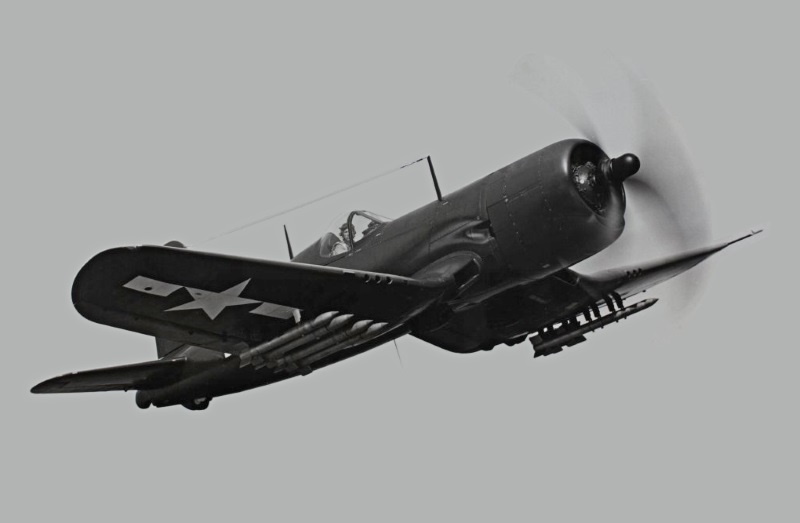
Five F4U-1s were modified as "XF4U-4" prototypes, with the first performing its initial flight on 19 April 1944. One of the prototypes was fitted with a prop spinner, but this item was not adopted for production. Initial flight of a production F4U-4 was in September 1944, with initial service deliveries in October. A dozen (some sources claim only two) F4U-4s were built by Goodyear with the designation of "FG-4", but the end of the war led to cancellation of further Corsair orders from Goodyear. However, the Navy was still appreciative enough of the F4U-4 to obtain about 400 more from Vought after the war up to 1947.
2,037 standard F4U-4s were built in all. Several subvariants of the F4U-4 were built as well:
An F4U-4 was experimentally fitted with wingtip fuel tanks and another was used for trials of a six-bladed contra-rotating propeller, but neither of these items was ever incorporated into Corsair production.
* One of the more interesting wartime Corsair variants, even if it didn't go into production, was the Goodyear "F2G", which was to be designed around the monster P&W R-4360-4 air-cooled radial engine, with 2,238 kW (3,000 HP) take-off power. In contrast to the R-2800 Double Wasp, which featured two rows of nine cylinders for a total of 18 cylinders, the R-4360 featured four rows of seven cylinders for a total of 28 cylinders; it was called a "corncob" because of the cylinder arrangement. The engine would see operational service on the big Convair B-36 Peacemaker heavy bomber and other aircraft after the war.
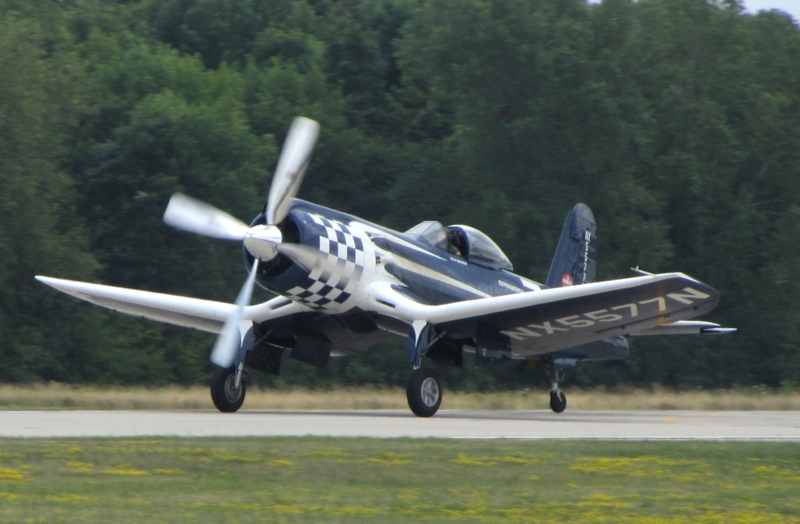
The F2G had a distinctive supercharger / oil system cooler intake on top of the lengthened nose, as well as a bubble-type canopy, a taller tailfin, and other changes. A bubble canopy had been fitted earlier to a Goodyear FG-1A on a trials basis. Armament was six 12.7-millimeter Brownings, plus the external stores arrangement of the F4U-1D.
An old F4U-1 with the birdcage canopy was fitted with the Wasp Major and a four-bladed prop in early 1944 to evaluate the fit. Goodyear received a production contract for the F2G in March 1944, with some of the batch for use from ground bases, featuring manually folding wings and designated "F2G-1"; and others for carrier operations, with hydraulically folding wings and an arresting hook, designated of "F2G-2". Development, particularly of the engine, proved troublesome, and by the time the first F2G was rolled out in May 1945, the need for the type was evaporating.
Production contracts for the variant were canceled at the end of the war, with only five production F2G-1s and five F2G-2s built. They had been preceded by a number of "XF2G" prototypes, the precise count being unclear, with most or all of these development machines apparently being conversions. At least one F2G flew in air races after the war.
BACK_TO_TOP* The British Royal Navy Fleet Air Arm (FAA) warmed to the Corsair much faster than the US Navy. In November 1943, the FAA received under Lend-Lease the first of 95 Vought F4U-1s, which were given the designation of "Corsair I". The first squadrons were assembled and trained in the US, either at Brunswick, Maine, or Quonset, Rhode Island, and then shipped across the Atlantic. The Royal Navy put the Corsair into carrier operations immediately, well ahead of the US Navy, though it wasn't like the British worked miracles with the F4U: they found its landing characteristics just as beastly, suffering a number of fatal crashes, but bit the bullet and did it anyway.
This initial British batch was followed by 510 Vought F4U-1As under the designation of "Corsair II"; 430 Brewster F3A-1Ds under the designation of "Corsair III"; and finally 977 Goodyear FG-1Ds under the designation of "Corsair IV" -- for a total of 2,012 FAA Corsairs. It is unclear if the stateside squadron training scheme was retained for all British Corsair squadrons.
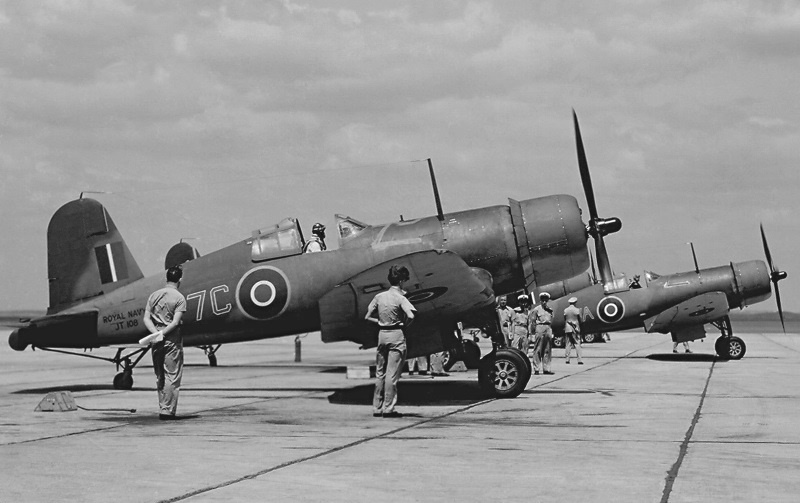
All but initial deliveries of FAA Corsairs had 20 centimeters (8 inches) clipped from the wingtips to permit storage in British carrier hangar decks, with the clipped wings also apparently improving the roll rate. Some sources suggest that at least some of the clipped-wing Corsairs supplied to Britain had the US designation of "F4U-1B". Many FAA Corsairs were fitted with rails for launching British 7.62-centimeter (3-inch) unguided "Rocket Projectiles (RP)". At its peak, the Corsair equipped 19 FAA squadrons.
FAA Corsairs originally fought in a camouflage scheme, with a light-green / dark-green disruptive pattern on top and a white belly, but were later painted overall blue. Those operating in the Pacific theater acquired a specialized British insignia -- a modified blue-white roundel with white "bars" to make it look more like a US than a Japanese insignia to prevent friendly-fire incidents.
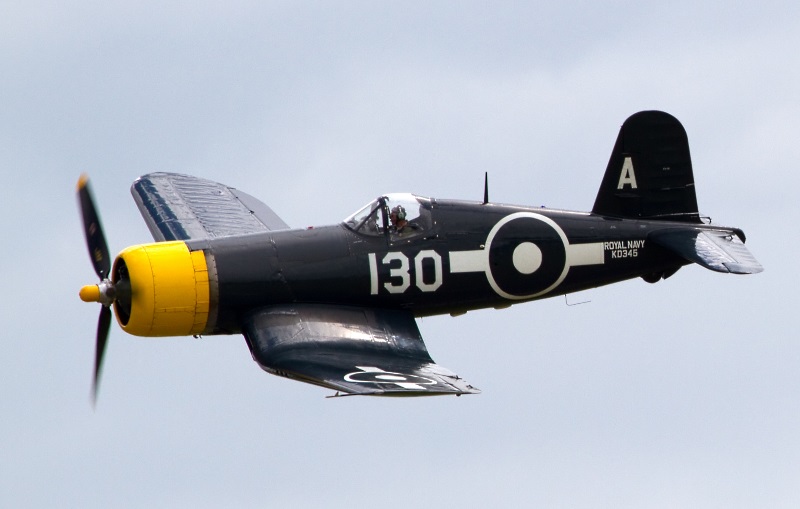
FAA Corsairs performed their first combat action on 3 April 1944, with Number 1834 Squadron flying from the HMS VICTORIOUS to help provide cover for a strike on the German super-battleship TIRPITZ in a Norwegian fjord. This was apparently the first combat operation of the Corsair off of an aircraft carrier. Further attacks on the TIRPITZ were performed in July and August 1944, with Corsairs from the HMS FORMIDABLE participating. The Corsairs did not encounter aerial opposition on these raids, and in fact the F4U would never have it out with German Luftwaffe aircraft. A confrontation between a Corsair and the tough German Focke-Wulf Fw 190 would have made for an interesting contest.
After the Norwegian operations, British Corsairs switched operations to the Indian Ocean to fight the Japanese, with the first operational sorties on 19 April 1945. Royal Navy carriers would be participants in the final battle for the Japanese home islands. On 9 August 1945, days before the end of the war, Corsairs from HMS FORMIDABLE were attacking Shiogama harbor on the northeast coast of Japan. A Canadian pilot, Lieutenant Robert H. Gray, was hit by flak but pressed home his attack on a Japanese destroyer, sinking it with a 450-kilogram (1,000-pound) bomb, and then crashing into the sea. He was posthumously awarded the last Victoria Cross of World War II.
At least 424 Corsairs were also provided to the Royal New Zealand Air Force, beginning in late 1943, with a little more than half of them F4U-1As and the rest F4U-1Ds / FG-1Ds. By the time the New Zealanders had worked up to operational Corsair squadrons in 1944, there was little for them to shoot at in the air and they scored no kills, but they kept busy in the attack role, with a fair number of them shot down or lost in accidents. Most of the New Zealander Corsairs were scrapped after the war, as were the British Corsairs.
BACK_TO_TOP